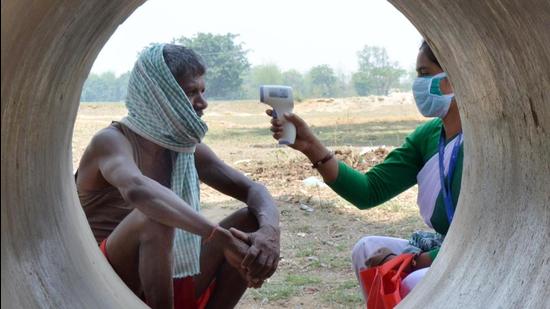Covid-19 and the disease of inequality
The second wave will deepen inequality. Expand support to states, universalise PDS, and ramp up MGNREGS now
Abandoned by the State that insisted on locking down, refusing to recognise the damage done to their livelihoods, India’s workers asserted their rights and made themselves heard by walking home in March 2020. The long march home was emblematic of the suffering and hardship unleashed by the first wave.

A year later, it is India’s broken health system and the suffering it has unleashed even on the most privileged that have dominated public imagination. Ironically, the scale of the health crisis has rendered invisible the deepening livelihood crisis that India confronts, drowning out the voices that fought a callous State and asserted their rights barely a year ago. It is a measure of how easily the State abandons its people that two months into the second wave, the looming livelihood crisis awaits acknowledgement by the government and relief, such as it is, remains sporadic and inadequate. The poor, long abandoned by India’s broken health system, is now being forced to suffer the indignity of abandoning their dead.
Also Read | India runs the risk of losing its pharma edge
The second wave hit an economy that was showing signs of deepening structural inequality caused by Covid-19. The recently released State of Working India report by researchers at the Azim Premji University points out that 2020 saw a dramatic decrease in incomes for a majority of India’s workers. The cumulative income loss was higher among poorer households (27% for the bottom 10%). For the poor, the loss of income on a low base inevitably resulted in a significant cutback in consumption. A Hunger Watch survey points out that in October 2020, one in three respondents reported skipping meals “sometimes” or “often”, and 71% of households reported a worsening in the nutritional quality of their food intake.
The dynamics of India’s post-lockdown economic recovery pointed to a structural problem, which India failed to confront in 2020. The formal economy, notably large, saw listed firms benefitting through the pandemic at the cost of, as economist Pranjul Bhandari has pointed out, putting several small and informal firms that employ the bulk of India’s workers, in distress. This profit-led, jobless recovery saw formal salaried employees entering informal employment. Drawing on Centre for Monitoring Indian Economy (CMIE) data, the State of Working India report reveals that nearly half of India’s formal salaried workers moved into informal work, either as self-employed (30%), casual wage (10%) or informal salaried (9%) workers, in 2020.
The State, on its part, responded with a bare minimal relief. This did little to stem rising inequality. The limited fiscal stimulus and lack of income support arguably contributed to deepening inequality, even as it provided some succour against extreme hunger and starvation.
The second wave has brought with it a new set of challenges that will exacerbate inequality. First, because the Centre has abdicated all responsibility, state governments are charting their course. The result has been a medley of state-level lockdowns, with the burden of providing economic relief now solely on state governments.
In principle, state governments ought to lead the charge on relief and income support, for they are likely to face differential economic consequences, linked to disease transmission dynamics and state-specific socioeconomic profiles. However, now that states are being asked to take on the financial burden for vaccines, health infrastructure and relief, adequate fiscal support, denied in the first wave from the Centre to states, is critical. Absent this, relief measures, especially in poorer states, will inevitably be sporadic and inadequate.
Also Read | Tough but crucial lockdown decision enabled Delhi to tame deadliest wave
Second, state governments have failed to learn crucial lessons from 2020. The one relief measure announced by the Centre, and complemented by state-specific efforts, has been the reinstatement of last year’s provision of supplementary food rations through the public distribution system (PDS). However, migrant workers were ignored. It has taken the interventions of the Supreme Court to get state governments to expand grain provision to migrant workers who, despite grand announcements of one-nation one-ration card, still do not have access to PDS outside their home states. And even today, bureaucratic obsession with paperwork and the need to distribute temporary ration cards, is coming in the way of enabling easy access. In recent weeks, NGOs are reporting a rise in distress calls.
Finally, unlike last year, Covid-19 is now spreading to rural areas. In 2020, India’s workers relied heavily on the rural economy to survive the crisis and the economy depended on rural demand. This is not the case now. CMIE data is indicating increased unemployment in rural India in May. And demand for Mahatma Gandhi National Rural Employment Guarantee Scheme (MGNREGS) has outstripped supply. The livelihood crisis is visible and stark.
Reports have it that the Centre is mulling over a fiscal stimulus, no doubt worrying about its implications for fiscal deficit and spooking markets. Yet the longer the government takes to act, the greater will be the demand shock. The policy prescriptions are well known. We need expanded fiscal support to state governments, universal PDS, continuous and expanded funding of MGNREGS. The Indian economy cannot afford a callous State. If not for citizens, then at least for the markets, the State needs to act now.
Yamini Aiyar is president and chief executive, Centre for Policy Research
The views expressed are personal
Continue reading with HT Premium Subscription




